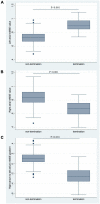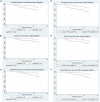A novel approach for quantitative electrogram analysis for driver identification: Implications for ablation in persistent atrial fibrillation
- PMID: 36531714
- PMCID: PMC9751199
- DOI: 10.3389/fcvm.2022.1049854
A novel approach for quantitative electrogram analysis for driver identification: Implications for ablation in persistent atrial fibrillation
Abstract
Objective: This study sought to study the feasibility, efficacy, and safety of using multiscale entropy (MSE) analysis to guide catheter ablation for persistent atrial fibrillation (PsAF) and predict ablation outcomes.
Methods: We prospectively enrolled 108 patients undergoing initial ablation for PsAF. MSE was calculated based on bipolar intracardiac electrograms (iEGMs) to measure the dynamical complexity of biological signals. The iEGMs data were exported after pulmonary vein isolation (PVI), then calculated in a customed platform, and finally re-annotated into the CARTO system. After PVI, regions of the highest mean MSE (mMSE) values were ablated in descending order until AF termination, or three areas had been ablated.
Results: Baseline characteristics were evenly distributed between the AF termination (n = 38, 35.19%) and the non-termination group. The RA-to-LA mean MSE (mMSE) gradient demonstrated a positive gradient in the non-termination group and a negative gradient in the termination group (0.105 ± 0.180 vs. -0.235 ± 0.256, P < 0.001). During a 12-month follow-up, 29 patients (26.9%) had arrhythmia recurrence after single ablation, and 18 of them had AF (62.1%). The termination group had lower rates of arrhythmia recurrence (15.79 vs. 32.86%, Log-Rank P = 0.053) and AF recurrence (10.53 vs. 20%, Log-Rank P = 0.173) after single ablation and a lower rate of arrhythmia recurrence (7.89 vs. 27.14%, Log-Rank P = 0.018) after repeated ablation. Correspondingly, subjects with negative RA-to-LA mMSE gradient had lower incidences of arrhythmia (16.67 vs. 35%, Log-Rank P = 0.028) and AF (16.67 vs. 35%, Log-Rank P = 0.032) recurrence after single ablation and arrhythmia recurrence after repeated ablation (12.5 vs. 26.67%, Log-Rank P = 0.062). Marginal peri-procedural safety outcomes were observed.
Conclusion: MSE analysis-guided driver ablation in addition to PVI for PsAF could be feasible, efficient, and safe. An RA < LA mMSE gradient before ablation could predict freedom from arrhythmia. The RA-LA MSE gradient could be useful for guiding ablation strategy selection.
Keywords: AF driver mapping; catheter ablation; long-term outcomes; multiscale entropy; persistent atrial fibrillation.
Copyright © 2022 Shi, Wu, Zou, Xu, Jiang, Zhang, Qin and Liu.
Conflict of interest statement
The authors declare that the research was conducted in the absence of any commercial or financial relationships that could be construed as a potential conflict of interest.
Figures





References
-
- Hindricks G, Potpara T, Dagres N, Arbelo E, Bax JJ, Blomström-Lundqvist C, et al. 2020 ESC guidelines for the diagnosis and management of atrial fibrillation developed in collaboration with the European association for cardio-thoracic surgery (EACTS): the task force for the diagnosis and management of atrial fibrillation of the European society of cardiology (ESC) Developed with the special contribution of the European heart rhythm association (EHRA) of the ESC. Eur Heart J. (2021) 42:373–498. 10.1093/eurheartj/ehaa612 - DOI - PubMed
LinkOut - more resources
Full Text Sources

